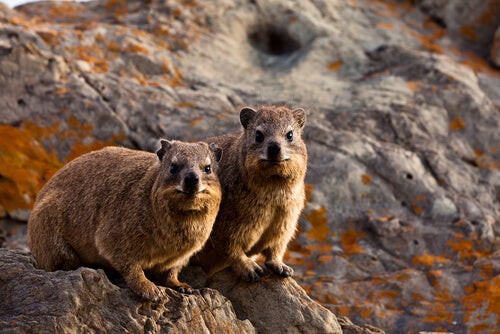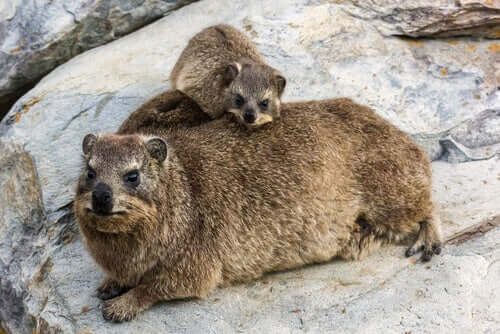The Acrobatic Rock Hyrax

The rock hyrax looks very similar to a guinea pig or a large rabbit with very short ears. But this animal has teeth, toes, and a cranial structure very similar to that of an elephant. In fact, the similarities are so strong that some scientists believe the rock hyrax to be one of the elephant’s closest living relatives.
The hyrax’s strong molars grind hard vegetation and they have two incisors like small fangs, just like an elephant.
Life on the rocks
This species belongs to the Procaviidae or Hyrax family and there are three different types. The rock hyrax, tree hyrax, and yellow-spotted hyrax. The rock hyrax lives mainly in Africa, but it can also be found on the coasts of the Arabian peninsula and towards Lebanon.
As its name implies, they gather in rocky areas, rocky formations, or even on small corners on cliffs that provide shelter and protection. It’s easy to identify where they live since their urine crystallizes and looks like white marks on the rocks.
The rock hyrax’s legs are designed for rock climbing. The lower part of each leg is bare and has a wet, rubbery pad which is raised in the middle for a suction cup effect. This helps the rock hyrax to climb rocks and other smooth surfaces without slipping.
Behavioral traits of the rock hyrax
The rock hyrax is a very sociable species and can be found in colonies of up to 50 individuals sharing sleeping areas and looking for food together. Each day begins with the group sunbathing for several hours. Once they’ve warmed up, they venture out for a short while to feed.

The rock hyrax doesn’t like the rain or the cold and won’t even leave its shelter if they don’t like the look of the weather. Although they normally go out during the day, they can also go out in the moonlight. However, they spend most of their time doing nothing. Only about 5% of their time is spent being active.
In some parts of Africa, the tree hyrax lives in the same rocky areas as the rock hyrax. The two species have been observed sharing shelters and gathering together to warm up in the morning. Their puppies even play together. Although they are different in other aspects, these two species seem to understand each other.
Eating habits
The rock hyrax has a three-compartment stomach containing bacteria to help digest the plants they eat. During the wetter season, they mainly eat grass. But when the grass dries, they switch to eating fruits and leaves.
They feed in a circle shape, with their heads pointing outwards to keep an eye out for predators. The main animals they’re watching for are jackals, leopards, hyenas, and the black eagle.

Because of its excellent eyesight, the rock hyrax can spot a predator more than 3000 feet away. Whenever feeding, the dominant male in the group stops between bites to watch for danger. If he sees something concerning, he lets out a cry so that the rock hyraxes can look for cover or remain completely still until the danger has passed.
Family life for the rock hyrax
Female rock hyraxes stay with their family for their whole lives. There’s one male for every five females who patrols a particular territory within their colony. When a baby is born, which usually happens around the same time each year, the entire colony greets and smells the newborn.
The puppies are surprisingly well-developed. They’re born with their eyes and ears open and they look like miniature adults with the same lush fur. The rock hyrax organizes itself in groups to take care of their young and the mothers take turns to take care of them.
Three days after birth, the puppies are already eating solid foods. The puppies eat the excrement of other hyraxes. It’s believed that this habit helps them to get the bacteria needed for their stomachs so that they can digest the plants that they eat.
All cited sources were thoroughly reviewed by our team to ensure their quality, reliability, currency, and validity. The bibliography of this article was considered reliable and of academic or scientific accuracy.
- https://nationalzoo.si.edu/animals/rock-hyrax
This text is provided for informational purposes only and does not replace consultation with a professional. If in doubt, consult your specialist.